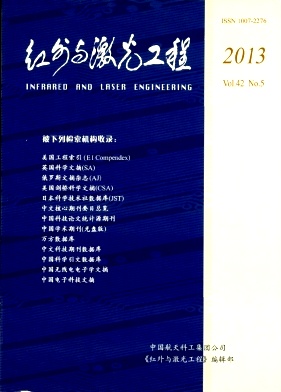Li Rong, Wang Sen, Shi Huli. Thermal effect on the vanes in the main optical telescope of the solar space telescope[J]. Infrared and Laser Engineering, 2013, 42(5): 1291-1297.
| Citation:
|
Li Rong, Wang Sen, Shi Huli. Thermal effect on the vanes in the main optical telescope of the solar space telescope[J]. Infrared and Laser Engineering, 2013, 42(5): 1291-1297.
|
Thermal effect on the vanes in the main optical telescope of the solar space telescope
- 1.
Hangzhou Dianzi University,Hangzhou 310018,China;
- 2.
National Astronomical Observatories,Chinese Academy of Sciences,Beijing 100012,China
- Received Date: 2012-09-12
- Rev Recd Date:
2012-10-13
- Publish Date:
2013-05-25
-
Abstract
The space solar telescope(SST) is designed to obtain its diffraction limit quality with aperture over one meter. It observes the sun with a small view field of 2.8'1.5' to obtain its high spatial resolution imaging of 0.1-0.15. SST observes the sun directly can receive huge heat flow more than 1 000 W that will lead to unacceptable thermal distortion of the optical components. The sunlight enters into the telescope, which is an intense source of both heat and stray light. Based on the special thermal effect and stray light in the solar telescope, a compatibility analysis of the thermal effect of vanes in SST was performed. In the compatibility analysis, the geometric parameter of vane structure became a key point which would affect the geometry composing function(GCF) in stray light analysis and affect the radiation shape factor in thermal analysis synchronously. This paper presented the relationship between the thermal control design and scatting elimination plan on the vane structures in SST. The objective and method of the compatibility analysis were determined. With the thermal analysis software, the temperature fields were calculated for different geometric parameters of vane structure including depth, separation, and angle. A design of the vane structure was put forward in thermal control terms and the suggestion was put out synchronously, which restrains the vanes with less depth, more separation to the primary mirror and angled at 90. The aims of the optimal design of the vane structure of SST were studed reached. The thoughts and methods of the optimal analysis are also useful for similar optical telescopes designed for solar observation.
-
References
|
[1]
|
Spagnesi C, Vannoni M, Molesini G. Thermal effects in the solar disk sextant telescope[C]//SPIE, 2004, 5249: 746-753. |
|
[2]
|
|
|
[3]
|
Xu Rong, Shi Huli. Thermal effect analysis of main structure in space solar telescope[J]. Infrared and Laser Engineering, 2011, 40(12): 2425-2431. (in Chinese) |
|
[4]
|
|
|
[5]
|
|
|
[6]
|
Yang Dehua, Jiang Zibo, Li Xinnan. Integrated thermal disturbance analysis of optical system of astronomical telescope[C]//SPIE, 2008, 7017: 70171N. |
|
[7]
|
|
|
[8]
|
Stefan Dwnis, Pierre Coucke, Eric Gabriel, et al. Multi-application solar telescope: assembly, integration and testing[C]//SPIE, 2010, 7733: 773335. |
|
[9]
|
Stefan Denis, Pierre Coucke, Eric Gabriel, et al. Optomechanical thermal design of the multi-application solar telescope for USO[C]//SPIE, 2008, 7012: 701235. |
|
[10]
|
|
|
[11]
|
Hopkins Randall C, Peter Capizzo, Sharon Fincher, et al. Spacecraft conceptual design for the 8-meter advanced technology large aperture space telescope(ATLAST)[C]//SPIE, 2010, 7731: 77312Q. |
|
[12]
|
|
|
[13]
|
|
|
[14]
|
Thomas Rimmele, Keil Stephen L, Christoph Keller, et al. Technical challenges of the advanced technology solar telescope[C]//SPIE, 2003, 4837: 94-109. |
|
[15]
|
|
|
[16]
|
Suematsu Y, Katsukawa Y, Shimizu T. Short telescope design of 1.5m aperture solar UV visible and IR telescope aboard solar-C[C]//SPIE, 2011, 8148: 81480D. |
|
[17]
|
Meftah M, Irbah A. The space instrument SOOISM, a telescope to measure the solar diameter[C]//SPIE, 2011, 8146: 81460Z. |
|
[18]
|
|
|
[19]
|
Ester Antonucci, Marco Romoli, Daniele Gardiol, et al. Ultraviolet and visible-light coronagraphic imager (UVCI) for HERSCHEL(Helium Resonance Scattering in Corona HELiosphere)[C]//SPIE, 2003, 4853: 162-171. |
|
[20]
|
|
|
[21]
|
|
|
[22]
|
Wang Sen. Study on Thermal-Optical of Space Solar Telescope[M]. Beijing: National Astronomical Observatories, Chinese Academy of Sciences, 2005: 98-122. (in Chinese) |
|
[23]
|
|
|
[24]
|
Li Rong, Wang Sen. Thermal analysis of the baffle structure of the Solar Space Telescope[J]. Science China: Physics, Mechanics and Astronomy, 2010, 53(9): 1755-1764. |
|
[25]
|
Michael B. Control of Stray Light[M]//2nd ed. Handbook of Optics, Chapter 28, Vol. 1. NewYork: Mc Gravo-Hill. Inc, 2000. |
-
-
Proportional views

-









 DownLoad:
DownLoad: